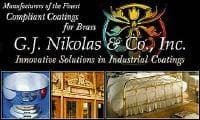
Home of the world famous 'finishing.com HOTLINE' since 1989
-----
How to Remove Varnish from Brass
Some people will want bare brass so they can patinate or decorate it in some way, but many buyers do not want a bare brass finish because it will turn spottily brown quickly, especially in a humid kitchen or bathroom, so nearly all brass is offered with a clearcoat finish of some sort.
Most homeowners also don't want the hassle of stripping & redoing brass lacquer every several year, so today's factory-applied clearcoats may be far more robust radiation cured or other exotic clearcoats that may not be as easy to remove.
Q. I am renovating my kitchen, and would like to install an unlacquered brass faucet. Unfortunately, to buy unlacquered brass will cost me no less than $1k, whereas the same piece with some layer/finish is considerably less expensive.
I know there are a number of ways to remove lacquer from brass (hot water/baking soda [in bulk on
eBay
or
Amazon [affil link]
bath, acetone
⇦ on
eBay
or
Amazon
[affil link] Flammable!
bath, Citrastrip), but are those safe for the interior bits of a faucet, ie. The pull down faucet hose, the connectors inside the handles, etc.? Many tutorials make it look simple, but Is this something I should leave to a professional?
Since I am starting from scratch (ie. Purchasing the faucet for this purpose) I also wonder if there are finishes that are easier or harder to remove? I actually read an article with someone who did it with a faucet with a chrome finish. So, I don't care what the finish is to begin with, as long as it's easy to remove and there's brass underneath.
Hobbyist! - Vermont
August 18, 2021
A. Please make sure the coated brass is not a plated material as most are. Call the MFG and ask what OTC stripper would work on the faucet. Some of these coatings are impossible to remove.
Mark RekdahlMetal Refinisher - SAN BERNARDINO, California
October 29, 2021
⇩ Related postings, oldest first ⇩
Q. I have an antique brass baby bed that I applied a coat of varnish on 20+ years ago. The bed was in storage and their was a fire so the smoke and heat have really messed the finish up. I need to remove the varnish, clean the brass and then reapply varnish, I think. I need information on removing the varnish, cleaning and what to use on it so it won't be toxic to my grandchild.
Barbara Thompson- Decatur, Alabama
2001
Q. I am trying to remove varnish from an antique brass trivet and I was wondering if you had any helpful advice to your query. Having trawled the net I have not found any answers. Can anyone help me? Thank you.
Anne Rolley- England
2003
Brass Trivets on eBay
A. Hi,
I've been looking for answers to the same question. I was particularly looking for a non-toxic way to remove the lacquer. I found the following link in a google search just now; haven't tried this yet, but wanted to pass it on:
www.heall.com/body/healthupdates/environment/nontoxiccleaning.html
- Palo Alto, California, USA
2004
Ed. note: Sorry, readers, that site is now defunct.
It suggested boiling the item in a solution of 2 tablespoons each of baking soda [in bulk on
eBay
or
Amazon [affil link]
and washing soda
⇦ on
eBay
or
Amazon [affil link]
in a non-aluminum pot until the lacquer peels off.
Q. I have a brass porch light fixture. I've tried cleaning it, but it is coated with some type of clear finish. Some of my cleaning (scrubbing) has removed the clear finish, but it's slow going from this point on and I want to know if there is any particular type of stripper that would make the job easier.
Also, what do you recommend to protect the bare brass once the clear finish is removed.
- Anderson, South Carolina
2004
I learned this technique in Army ROTC in college, where we were issued brass U.S. Army insignia for the uniform. These came coated with the clear varnish. Naturally, the varnish had to be removed so the brass could be polished thereafter. Barry Johnson
Blue Bell, PA USA
No dead threads!
Your Q, A, or Comment puts this thread on The Finishing.com HOTLINE.
